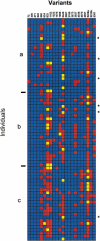Sequence diversity and large-scale typing of SNPs in the human apolipoprotein E gene
- PMID: 11042151
- PMCID: PMC310963
- DOI: 10.1101/gr.146900
Sequence diversity and large-scale typing of SNPs in the human apolipoprotein E gene
Abstract
A common strategy for genotyping large samples begins with the characterization of human single nucleotide polymorphisms (SNPs) by sequencing candidate regions in a small sample for SNP discovery. This is usually followed by typing in a large sample those sites observed to vary in a smaller sample. We present results from a systematic investigation of variation at the human apolipoprotein E locus (APOE), as well as the evaluation of the two-tiered sampling strategy based on these data. We sequenced 5.5 kb spanning the entire APOE genomic region in a core sample of 72 individuals, including 24 each of African-Americans from Jackson, Mississippi; European-Americans from Rochester, Minnesota; and Europeans from North Karelia, Finland. This sequence survey detected 21 SNPs and 1 multiallelic indel, 14 of which had not been previously reported. Alleles varied in relative frequency among the populations, and 10 sites were polymorphic in only a single population sample. Oligonucleotide ligation assays (OLA) were developed for 20 of these sites (omitting the indel and a closely-linked SNP). These were then scored in 2179 individuals sampled from the same three populations (n = 843, 884, and 452, respectively). Relative allele frequencies were generally consistent with estimates from the core sample, although variation was found in some populations in the larger sample at SNPs that were monomorphic in the corresponding smaller core sample. Site variation in the larger samples showed no systematic deviation from Hardy-Weinberg expectation. The large OLA sample clearly showed that variation in many, but not all, of OLA-typed SNPs is significantly correlated with the classical protein-coding variants, implying that there may be important substructure within the classical epsilon 2, epsilon 3, and epsilon 4 alleles. Comparison of the levels and patterns of polymorphism in the core samples with those estimated for the OLA-typed samples shows how nucleotide diversity is underestimated when only a subset of sites are typed and underscores the importance of adequate population sampling at the polymorphism discovery stage. [The sequence data described in this paper have been submitted to the GenBank data library under accession no. AF261279.]
Figures



Similar articles
-
Sequence polymorphism at the human apolipoprotein AII gene ( APOA2): unexpected deficit of variation in an African-American sample.Hum Genet. 2002 Jul;111(1):75-87. doi: 10.1007/s00439-002-0763-x. Epub 2002 Jun 14. Hum Genet. 2002. PMID: 12136239
-
Apolipoprotein E variation at the sequence haplotype level: implications for the origin and maintenance of a major human polymorphism.Am J Hum Genet. 2000 Oct;67(4):881-900. doi: 10.1086/303070. Epub 2000 Sep 13. Am J Hum Genet. 2000. PMID: 10986041 Free PMC article.
-
Contributions of 18 additional DNA sequence variations in the gene encoding apolipoprotein E to explaining variation in quantitative measures of lipid metabolism.Am J Hum Genet. 2002 Sep;71(3):501-17. doi: 10.1086/342217. Epub 2002 Aug 5. Am J Hum Genet. 2002. PMID: 12165926 Free PMC article.
-
SNP and haplotype variation in the human genome.Mutat Res. 2003 May 15;526(1-2):53-61. doi: 10.1016/s0027-5107(03)00014-9. Mutat Res. 2003. PMID: 12714183 Review.
-
On selecting markers for association studies: patterns of linkage disequilibrium between two and three diallelic loci.Genet Epidemiol. 2003 Jan;24(1):57-67. doi: 10.1002/gepi.10217. Genet Epidemiol. 2003. PMID: 12508256 Review.
Cited by
-
Alzheimer's disease models and functional genomics-How many needles are there in the haystack?Front Physiol. 2012 Aug 8;3:320. doi: 10.3389/fphys.2012.00320. eCollection 2012. Front Physiol. 2012. PMID: 22934069 Free PMC article.
-
Human DNA sequence variation in a 6.6-kb region containing the melanocortin 1 receptor promoter.Genetics. 2001 Jul;158(3):1253-68. doi: 10.1093/genetics/158.3.1253. Genetics. 2001. PMID: 11454772 Free PMC article.
-
Identifying disease polymorphisms from case-control genetic association data.Genetica. 2010 Dec;138(11-12):1147-59. doi: 10.1007/s10709-010-9505-5. Epub 2010 Oct 14. Genetica. 2010. PMID: 20949309
-
Variation in 5' promoter region of the APOE gene contributes to predicting ischemic heart disease (IHD) in the population at large: the Copenhagen City Heart Study.Ann Hum Genet. 2007 Nov;71(Pt 6):762-71. doi: 10.1111/j.1469-1809.2007.00370.x. Epub 2007 May 29. Ann Hum Genet. 2007. PMID: 17535270 Free PMC article.
-
Comprehensive association analysis of APOE regulatory region polymorphisms in Alzheimer disease.Neurogenetics. 2004 Dec;5(4):201-8. doi: 10.1007/s10048-004-0189-9. Epub 2004 Sep 29. Neurogenetics. 2004. PMID: 15455263
References
-
- Artiga MJ, Bullido MJ, Frank A, Sastre I, Recuero M, Garcia MA, Lendon CL, Han SW, Morris JC, Vazquez J, et al. Risk for Alzheimer's disease correlates with transcriptional activity of the APOEgene. Hum Mol Genet. 1998a;7:1887–1892. - PubMed
-
- Artiga MJ, Bullido MJ, Sastre I, Recuero M, Gracia MA, Aldudo J, Vazquez J, Valdivieso F. Allelic polymorphisms in the transcriptional regulatory region of apolipoprotein E gene. FEBS Lett. 1998b;421:105–108. - PubMed
-
- Bullido MJ, Artiga MJ, Recuero M, Sastre I, Garcia MA, Aldudo J, Lendon C, Han SW, Morris JC, Frank A, et al. A polymorphism in the regulatory region of APOE associated with risk for Alzheimer's dementia. Nat Genet. 1998;18:69–71. - PubMed
-
- Collins FS, Guyer MS, Chakravarti A. Variations on a theme: Cataloging human DNA sequence variation. Science. 1997;278:1580–1581. - PubMed
Publication types
MeSH terms
Substances
Associated data
- Actions
Grants and funding
LinkOut - more resources
Full Text Sources
Other Literature Sources
Medical
Molecular Biology Databases
Miscellaneous
